
18th century sailor’s chest
Painted iron
Rouen, Musée Le Secq des Tournelles - RMM, inv. LS. SN
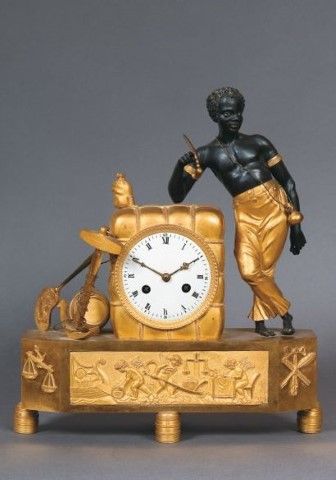
In the late 18th century, under the impetus of the philosophical writings of Jean-Jacques Rousseau, who celebrated the moral virtues of a return to nature through the myth of the “good savage”, the infatuation with exoticism was made fashionable (popular) by contemporary literature and fashionable through the French decorative arts. The black figure of the sailor could be as much that of an enslaved African as that of a “free colored” stevedore working in the West Indies or in France.
Clock known as “au nègre” representing a black sailor leaning on a cotton bale flanked by an anchor and a coffee barrel,
Rouen, early 19th century
Chased, gilded and patinated bronze
Galerie l’Astrée in Rouen, Pierre Lemaître Collection

This cane belonged to Pierre Desse, a ship captain in 1789, who made three slave trade expeditions on the “Union” and the “Joujou”. It illustrates the absolute authority of the captain, who wielded the power of life and death over the captives aboard his ship. Terror was the order of the day on slave ships, with the aim of crushing any acts of resistance or mutiny.
Cane
Late 18th century
Varnished hazelnut and ivory, length 65.7 cm
Bordeaux, Musée des Arts décoratifs et du Design, Accession No. 96.2.12. On loan to the Musée d’Aquitaine"

This globe shows the world as it was known to Europeans at the end of the 18th century. It is contained in a shark-skin case, the inside of which is decorated with a celestial sphere depicting the constellations. Of English origin and dated 1783, it bears the title “New terrestrial globe” due to the modifications made to reflect new discoveries.
Globe England,
1783 Shagreen, plaster, printed paper, diameter 13 cm
Bordeaux, Société Archéologique de Bordeaux, on loan to the Musée d’Aquitaine (Accession No. D 80.2.334)"
Armed in Bordeaux by the Journu brothers, the slave ship “Le Patriote” left Gironde on October 10, 1788 for the Seychelles, Pondicherry (now known as Puducherry), Isle de France (now Mauritius), Isle de Bourbon (now Réunion Island), the Cape of Good Hope, Ascension Island, and the Antilles. The ship’s captain records the navigation hazards and keeps a macabre tally of the captives who died during the passage, as indicated by the crosses in the margin. On Thursday, May 27, 1790, between two weather reports, the captain also describes a rape: “Beautiful moonlight, weather still the same. At 11 3/4, I brought a rather pretty negress up to my room, spent two hours with her, and exploited her twice. She was the first woman I’d seen since leaving France. Fine weather...” 216 men, women, and children were taken on board. 61 died of disease and exhaustion and 150 were sold at destination.
Navigation log of Paul Alexandre Brizard, Captain of the slave ship “Le Patriote” April 10, 1789 - February 17,
1791
Bordeaux, Société Archéologique de Bordeaux, on loan to the Musée d’Aquitaine (Accession No. D.80.2.49)
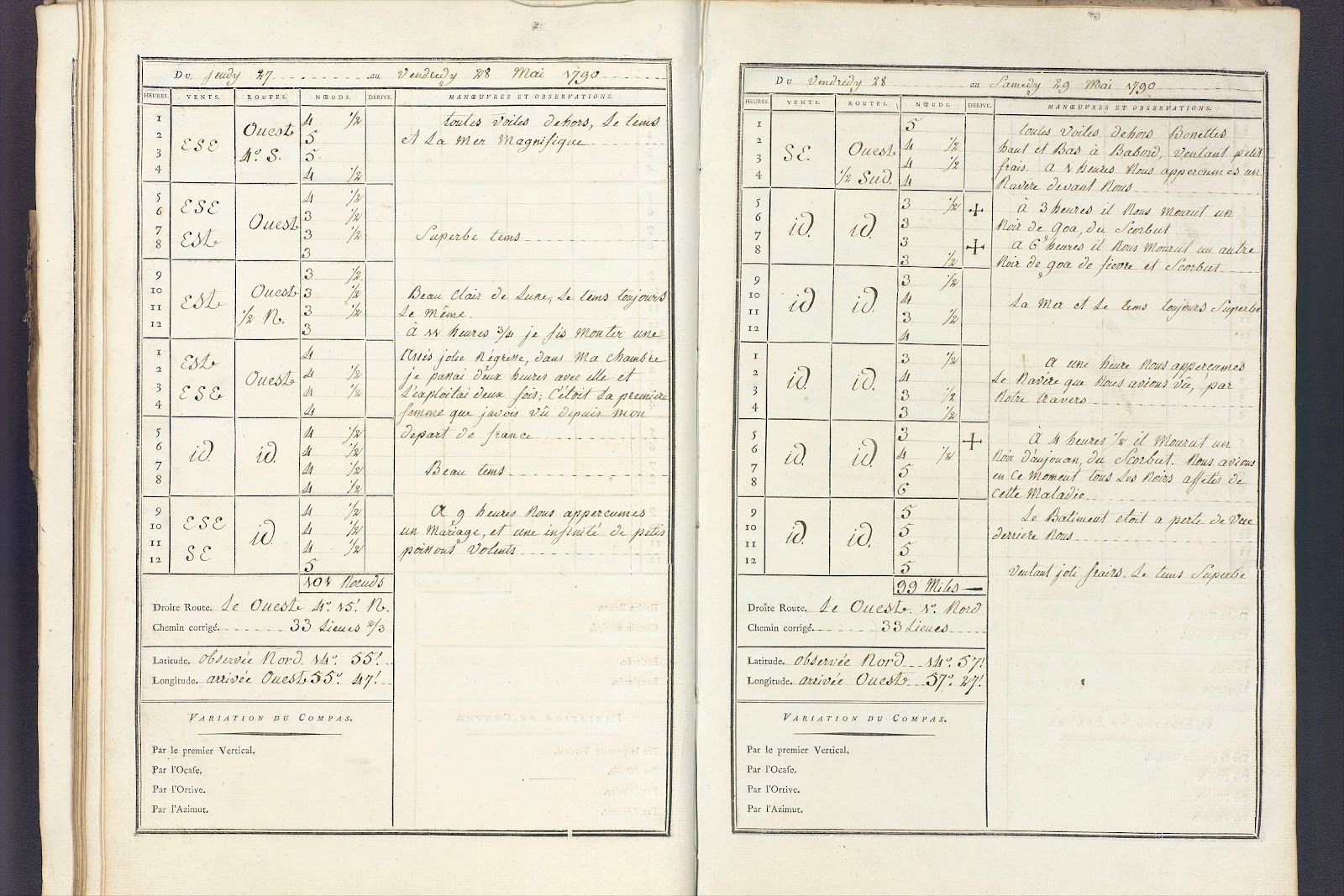
Journal de navigation de Paul Alexandre Brizard, capitaine du navire négrier Le Patriote Ajouter votre legende 10 avril 1789 – 17 février 1791 Bordeaux, Société Archéologique de Bordeaux, en dépôt au musée d’Aquitaine (D.80.2.49)

Journal de navigation de Paul Alexandre Brizard, capitaine du navire négrier Le Patriote Détails 10 avril 1789 – 17 février 1791 Bordeaux, Société Archéologique de Bordeaux, en dépôt au musée d’Aquitaine (D.80.2.49)
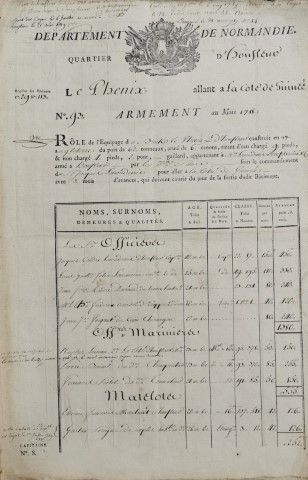
Rôle de l'équipage du brick Le Phénix d'Honfleur,
1788,
encre sur papier imprimé, 45 X 29 cm,
musée de la Marine, Honfleur, sans numéro
©David Gadanho
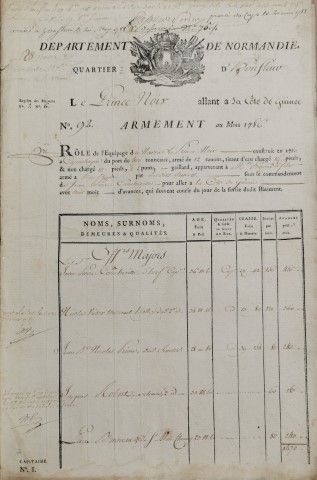
Rôle de l'équipage du navire Le Prince Noir,
1786,
encre sur papier, imprimé, 45 X 29 cm,
musée de la Marine, Honfleur, sans numéro
©David Gadanho
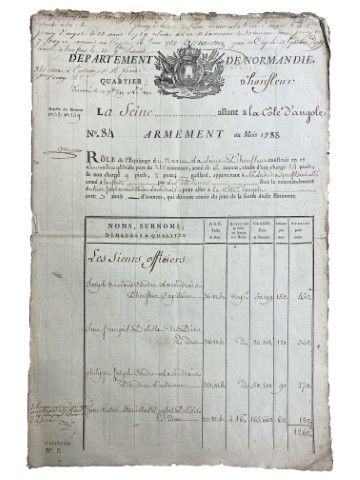
Rôle de l'équipage du navire La Seine,
1788,
encre sur papier imprimé, 44,5 X 29,5 cm,
musée de la Marine, Honfleur, sans numéro
© Frédéric Lefebvre

Rôle de l'équipage du navire La Bonne Amitié allant à la côte d'or,
1786,
encre brune sur papier vergé imprimé, 44,7 X 29,2 cm (format fermé),
musée de la Marine, Honfleur, inv.39.111
© Musées de Honfleur
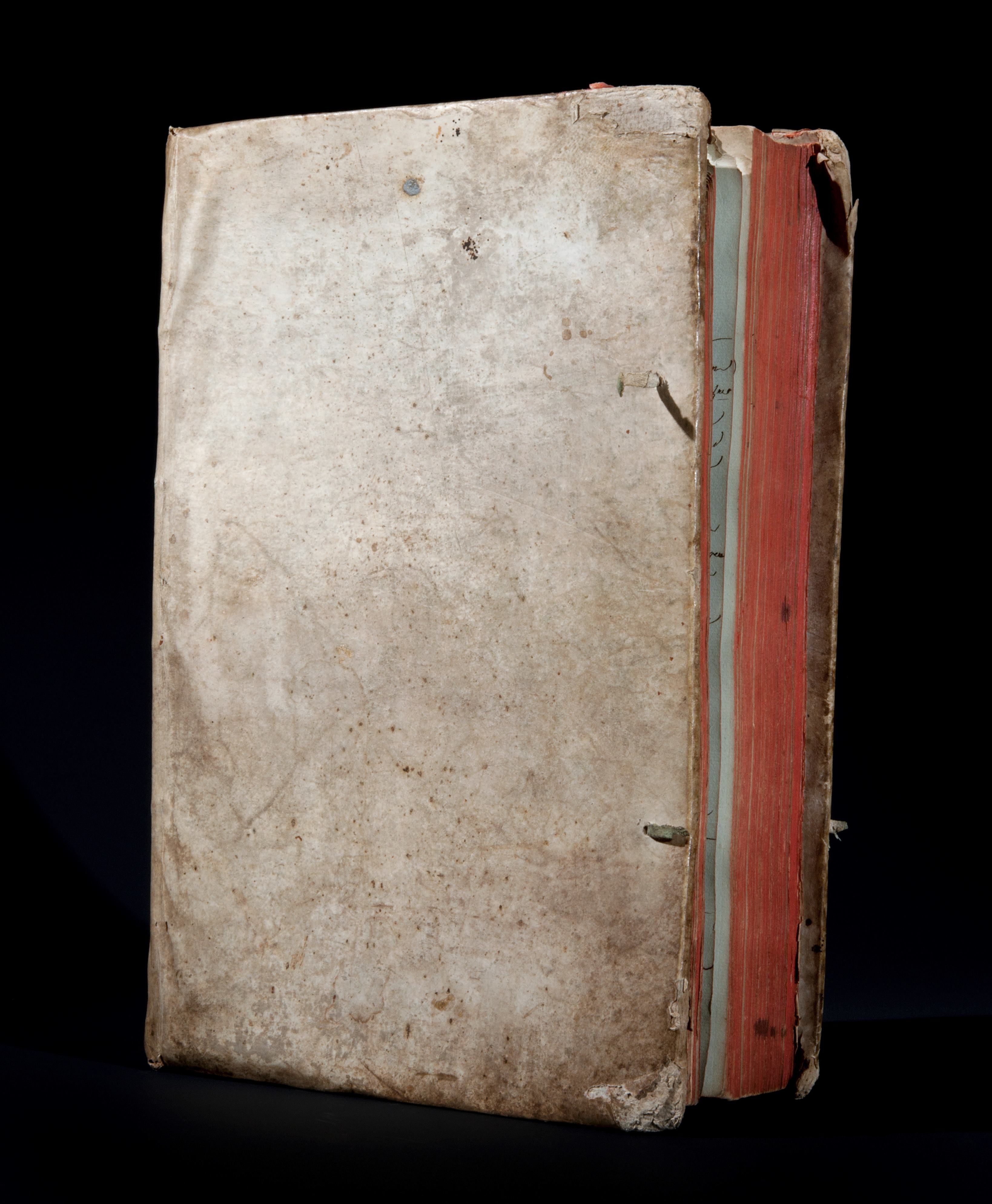
LEGLE Joseph-François Journal de bord du navire La Bonne Mère [Logbook of the ship La Bonne Mère] February 26th 1815 - July 13th 1815 ©Alain Guillard / Château des ducs de Bretagne - Musée d'histoire de Nantes
.png)
LEGLE Joseph-François Journal de bord du navire La Bonne Mère [Logbook of the ship La Bonne Mère] February 26th 1815 - July 13th 1815 ©Alain Guillard / Château des ducs de Bretagne - Musée d'histoire de Nantes
This item is the logbook of the ship La Bonne Mère. It reports a navigation table, some meteorological observations and other views and bearings of land and sails. This Nantes-based trading ship left the estuary in February 1815 and headed for Bonny on the African coast. At the time of its departure, the trade was legal in France but this was no longer the case when the English seized the ship on September 18th, 1815 near Pointe-à-Pître in Guadeloupe. This measure taken by Napoleon the Ist during the Hundred Days (March, 20 to June, 22, 1815) was reinforced two years later by Louis XVIII’s ban. Three loose sheets complete the diary: one is a double-page spread dated June 1st with payment to the second in command of the Spanish brig and to the pilot Brower and others (?). There is also a piece of paper with information on coastal navigation between Mindin and Lorient in 1814. The third sheet does not include any maritime or commercial instructions but is decorated with pen-and-ink drawings of ships.
Notice : © Château des ducs de Bretagne – Musée d’histoire de Nantes
LEGLE Joseph-François (1767-1834)
Journal de bord du navire La Bonne Mère, 26 février 1815 - 13 juillet 1815
[Logbook of the ship La Bonne Mère] February 26th 1815 - July 13th 1815
Ink on paper, 38.7 x 26.6 cm
Château des Ducs de Bretagne - Musée d’Histoire de Nantes, INV 997.9.1
Purchase